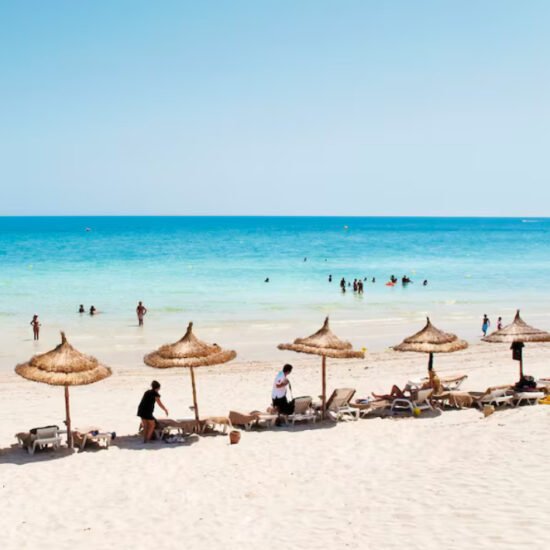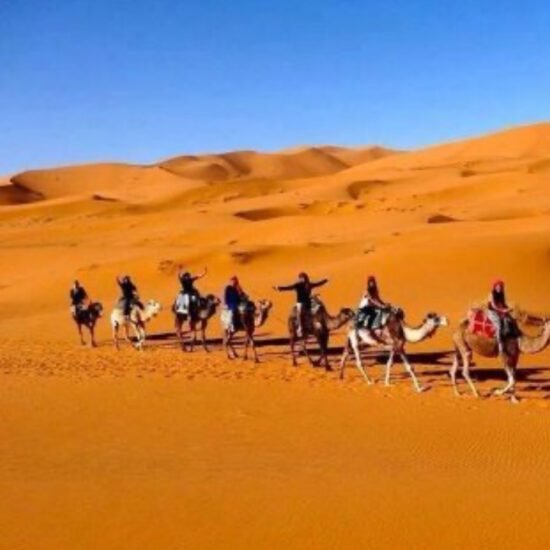
How is Merzouga Different from Agafay Desert
How is Merzouga Different from Agafay Desert?
The deserts of Morocco are admired worldwide by travelers attracted there, but the actual experience differs extremely from one desert location to another. Merzouga, Agafay, and Zagora are among the most famous desert destinations. While each provides a different environment and experiences, knowing how they differ is important for travelers looking for that perfect desert adventure. This article begins with a discussion on how Merzouga differs from the Agafay Desert and Zagora. The differing points include geography, ambiance, accessibility, and activities.
Geographic and Environmental Differences
Merzouga sits to the southeast of Morocco, close to its border with Algeria. Here Erg Chebbi dunes came to be famous as massive sand dunes that could rise up to 150 meters high. This vast dune sea is an iconic representation of desert Morocco, providing visitors with a prime Sahara experience. The sandy terrain stretches roughly 30 kilometers and is characterized by huge dunes of impressively soft sand that keep shifting with the desert winds.
Agafay, by contrast, is a rocky desert 40 kilometers southwest of Marrakech. It is not a sand desert like Merzouga but looks barren, moon-like, mostly made of granite stones and rugged hills. The terrain is dry and stony with sparse vegetation, presenting a resurrecting stark beauty quite unlike the sandy expanses of the Sahara.
Zagora is southward farther than Merzouga at the farthest tip of Draa Valley.
Famous for the Tinfou Dunes, they are much smaller and not as majestic as Erg Chebbi’s dunes. The desert here is more of a transition zone towards the Atlas Mountains from the Sahara, with sand, palm groves, and rocky landscapes in between. The dunes of Zagora have short desert stints, but they are not in the same league as the sands of Merzouga.
Accessibility and Travel Logistics
Accessibility is another major difference among these deserts. Merzouga lies some 560 kilometers by road from Marrakech and about 460 kilometers from Fes, necessitating an entire day-long or more journey to reach it. In either case, it is worth noting that beautiful drives through mountains, gorges, and traditional Berber villages constitute part of the entire experience.
Being so close to Marrakech, the Agafay Desert is enormously accessible. Within less than one hour of visiting, one can find a desert set-up if he wishes. This appeal is what attracts people who want to try it out but just do not have too much time.
Zagora is closer yet to Merzouga but nevertheless requires a 6 to 7-hour drive from Marrakech. The way crosses the well-known Draa Valley with palm oases and historic kasbahs providing plenty of stops with some culture on the side. Despite being easier to reach than Merzouga, it is the least-visited option amongst Agafay and Merzouga just on account of the small dunes and quieter atmosphere.
Types of Desert Experiences and Activities
The town of Merzouga is well known for aromatic Sahara immersion. Here visitors can enjoy multi-day camel treks through giant dunes, spend nights in traditional Berber-style camps under the stars, and engage in other activities such as sandboarding and stargazing. The enormity and natural beauty of the dunes provide an evocative backdrop for adventure and meditation.
Agafay offers a different desert experience. Since the desert is rocky and not sandy, camel rides tend to be shorter and less frequent while quad riding, ATV riding, or climbing in 4x4s on desert roads take center stage. Most visitors spend their vacation days in eco-lodges or luxury tents presenting splendid views over the rocky landscape, often interspersed with spa and wellness experiences. The desert’s close proximity to Marrakech ensures it to be much sought after for quick weekend getaways and private desert-themed celebrations.
Zagora desert experiences are more modest. The dunes here are smaller, and camel treks are usually short, a few hours at most. It provides a suitable choice for those looking for a basic Sahara taste without the hassle of long-distance travel or the grandeur of Merzouga. The region also hosts cultural tours to explore the palm groves, ancient ksars, and local markets.
Cultural and Environmental Contexts
Situated near the Algerian border, Merzouga’s geographical context defines a cultural context of its own. The local Amazigh (Berber) communities hold ancient desert traditions, so one encounters genuine hospitality, music, and local cuisine on arrival.
Having nearby seasonal lakes like Dayet Srji adds to the ecological value, providing rest for migratory birds and water sustenance to flying creatures in this arid patch.
With a progressively mixed culture owing to its proximity to Marrakech, the Agafay desert culture presents an interesting mix of traditional Berber elements and modern luxury tourism. Many luxury camps and resorts out here seek to give guests every comfort where desert adventure fell within this remit, from gourmet dining in intimate settings to spa therapies in an untamed environment.
The culture of Zagora remains a reflection of its former hub for trade routes. Describing it as a gateway to the Draa Valley, full of palm groves and kasbahs that signify the oasis culture of Morocco, is enough. While very calm compared to Merzouga, Zagora offers a version of desert scenery intermingled with agricultural spaces on the basis of sustainability and heritage.
Selecting the Appropriate Desert Experience
The choice between Merzouga, Agafay, and Zagora hinges on what specters of desires are held by travelers. Merzouga is appropriated for anyone wishing to admire Sahara dunes, complete with multi-day treks and nights immersed in the desert.
Agafay is suitable for those working on tight schedules or those who want a mix of rugged desert setting near Marrakech with modern comforts. Zagora provides a quieter and less touristy alternative with smaller dunes and stronger cultural projects focused on the Draa Valley.
While choosing these destinations, travelers interested in Morocco’s desert landscapes must consider the time constraints depending on activities preferred and atmosphere desired. Going on a long desert trip or requiring specialized knowledge calls for good local tour operators to ensure a safe, informative, and memorable experience.
Conclusion: Distant Destinations and Unique Experiences
In essence, Merzouga, Agafay Desert, and Zagora all afford various desert experiences depending on their geographic location, accessibility, and cultural backdrop. Vast dunes and genuine Sahara atmosphere make Merzouga be truly the desert destination in Morocco. Contrarily, Agafay Desert can offer another yet gorgeous boost of rocky landscape, closer to the hustle and bustle of Marrakech, while Zagora offers smaller dunes with more of the oasis culture for a quieter and more intimate desert experience.
If one develops a proper understanding of these discrepancies, they will be in complete control in choosing the most suitable one that suits their interests and schedules, thus yielding a worthy chase for the spectacular desert landscapes of Morocco.




